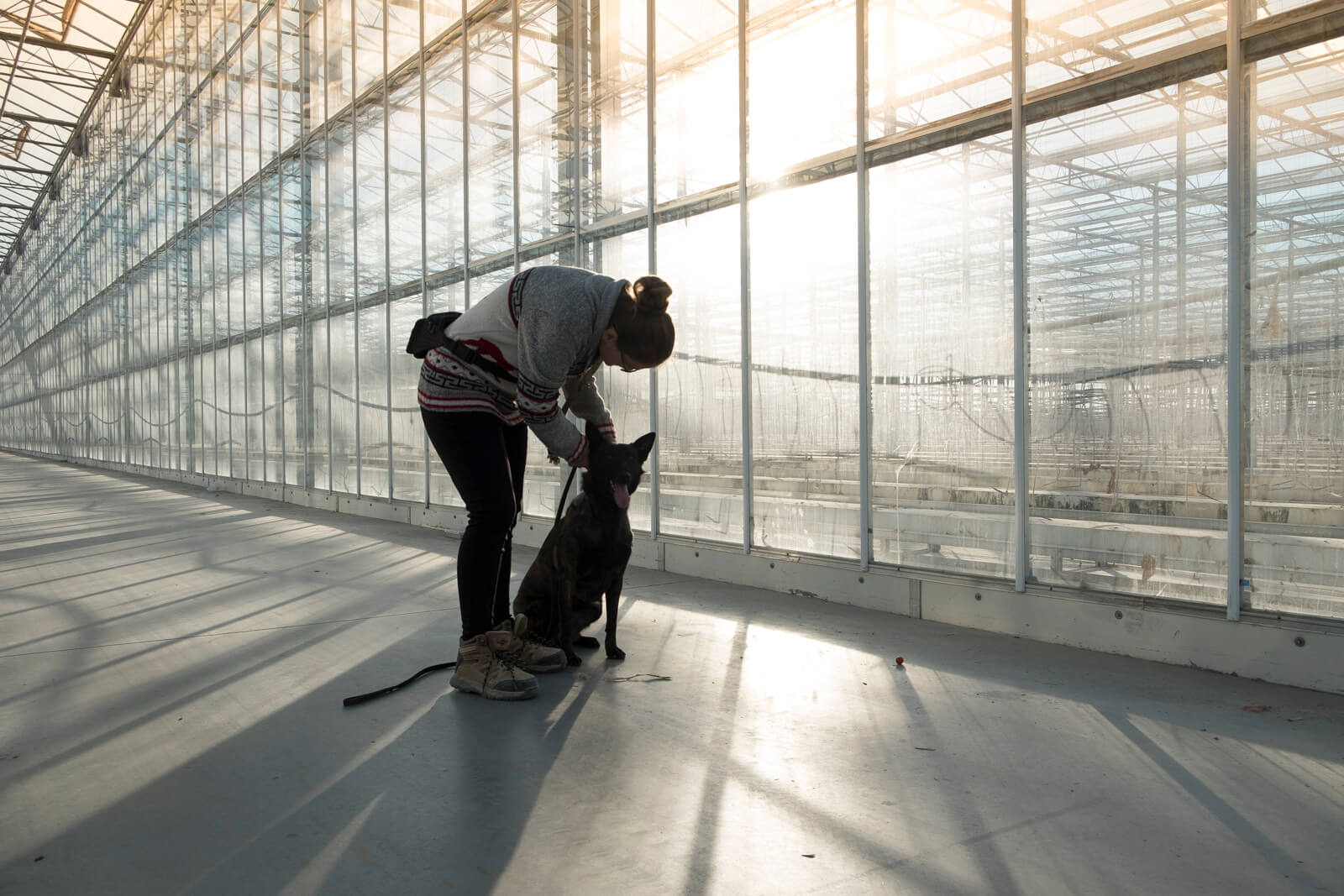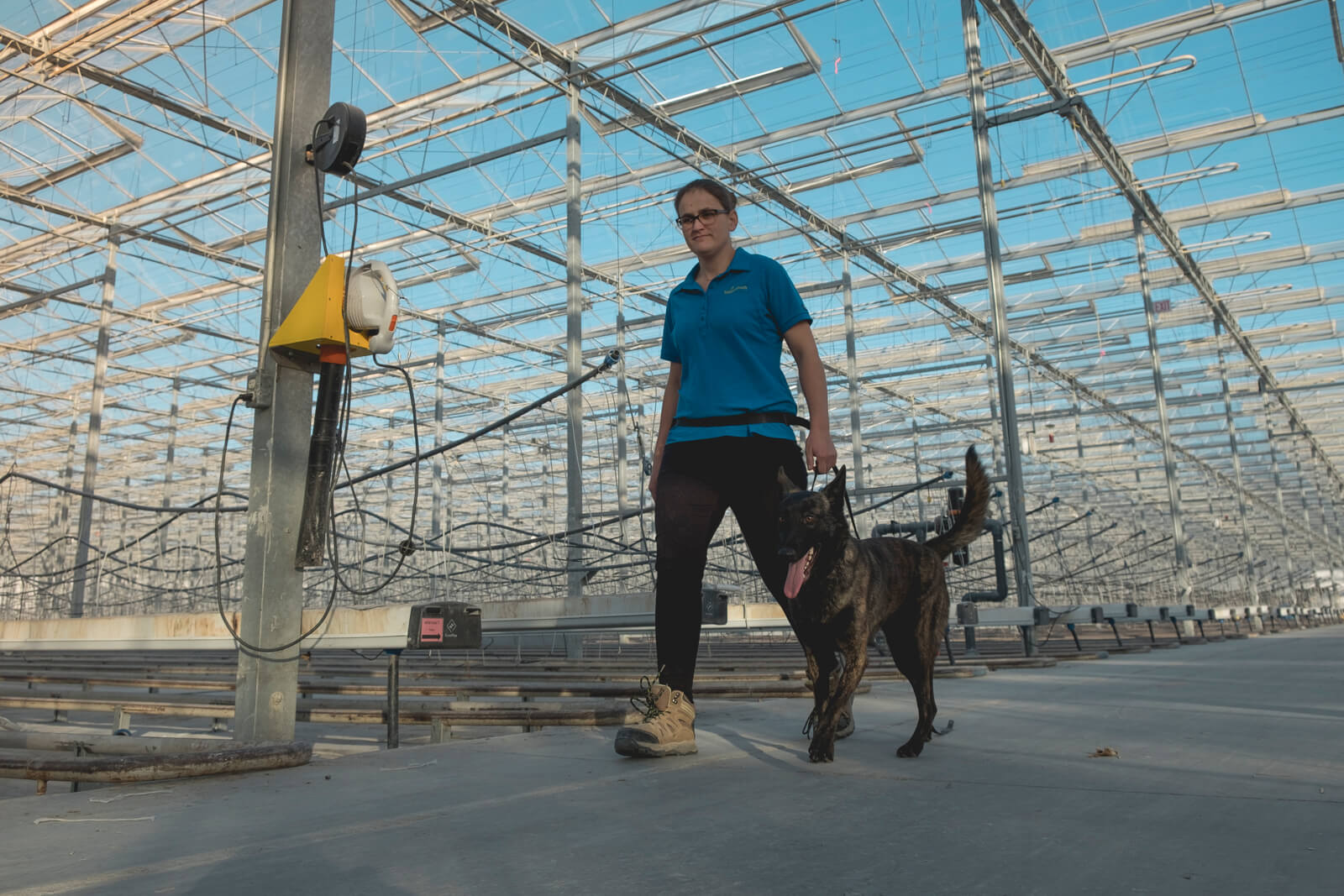Four months have now passed since Chili joined the Bug Brigade here at NatureFresh™, and it’s safe to say she is earning her keep. The thought of having a full-time working dog on a farm is an entirely new concept to our industry, and the initial uncertainties have all but faded now that Chili, and her handler, Tina, are developing a comfort level with their new positions and responsibilities.
 Skeptics aside, Chili has demonstrated with ease her ability to sniff out a single, tiny Pepper Weevil during her training sessions, as well as during demonstrations for our guests and fellow employees. The positive attention and response we have seen regarding her abilities and presence around the farm has been outstanding. As Chili and Tina enter a new work area, people stop what they are doing and watch her work. It really is remarkable how eager Chili is to please her handler and do her job while ignoring the attention of all the on-lookers.
Skeptics aside, Chili has demonstrated with ease her ability to sniff out a single, tiny Pepper Weevil during her training sessions, as well as during demonstrations for our guests and fellow employees. The positive attention and response we have seen regarding her abilities and presence around the farm has been outstanding. As Chili and Tina enter a new work area, people stop what they are doing and watch her work. It really is remarkable how eager Chili is to please her handler and do her job while ignoring the attention of all the on-lookers.
This is a new concept, and kind of a wild idea, but why even think of such a thing to help control bugs in our crop? How did we end up with a working dog? The answer is not so straightforward because pest management is very complex with many variables to consider. First of all, the pest in question, the Pepper Weevil, is invasive to our native environment in Ontario. It is a pest with a natural habitat of Mexico and the southern USA. Score 1 for the Weevil: it has no natural enemies in our environment, and we cannot purchase and import its natural enemies (Bio-Control Agents) because they too are not native to Canada. Bio-control is the backbone of our pest management (IPM) program, and without access to these beneficial organisms, we are left with less effective, less sustainable, and more invasive solutions.
Why can’t we just spray insecticides and be done with it? Not so simple, especially in the greenhouse environment. Pesticides come with all sorts of negative baggage, not to mention that Pepper Weevils have been exposed to decades of toxic insecticides in their southern range, so they are completely resistant to their effects by now. There are other tools, mind you, like insect exclusion screening on our vents, pheromone sticky trapping, human scouting, and bio-insecticides. But the Pepper Weevil is so different in so many ways that traditional IPM methods are just not enough.
We realized that if a single mated female Weevil was to survive our crop change in the winter, it could mean crop loss by early summer. With the intensive capital expense of greenhouse production, this is a fatal threat. You see, that a single Weevil is a needle in a haystack and it must be found. The motivation of this pest is also very focused and intense, because it requires peppers to feed and reproduce on. Many crop damaging insects have a wide host range and have options for food and egg-laying sites. Not the Weevil – this little fox-like bugger hones in on the scent of a pepper crop and slips in undetected, without leaving distinct evidence from feeding or egg-laying that most other pests will.
 Now you see why we needed to look outside the box and figure out how we can out-gun such a challenging pest. With Chili’s keen nose, and intensive drive to find Weevil, we stand to learn valuable information that is currently unavailable. This information is key to make further management decisions around the farm that could be the difference between sink or swim. One good example of an area we target is the outside greenhouse perimeter. The Weevil do fly, and are carried well with wind currents, but do they land on the ground and crawl to the sidewall of the greenhouse and look for a point of entry? If Chili starts finding Weevils on the ground outside, perhaps we can start spraying a bio-insecticide every few days around the perimeter, and apply new sticky tape on the outside walls on a regular basis. These are costly efforts and may be in vain if the Weevils are primarily carried in the wind and enter the greenhouse roof area. This is just one of many targeted areas we are focusing on with Chili to help us learn more about the behavior of this elusive pest.
Now you see why we needed to look outside the box and figure out how we can out-gun such a challenging pest. With Chili’s keen nose, and intensive drive to find Weevil, we stand to learn valuable information that is currently unavailable. This information is key to make further management decisions around the farm that could be the difference between sink or swim. One good example of an area we target is the outside greenhouse perimeter. The Weevil do fly, and are carried well with wind currents, but do they land on the ground and crawl to the sidewall of the greenhouse and look for a point of entry? If Chili starts finding Weevils on the ground outside, perhaps we can start spraying a bio-insecticide every few days around the perimeter, and apply new sticky tape on the outside walls on a regular basis. These are costly efforts and may be in vain if the Weevils are primarily carried in the wind and enter the greenhouse roof area. This is just one of many targeted areas we are focusing on with Chili to help us learn more about the behavior of this elusive pest.
As we are in December, our crop-change period has begun here in Leamington. During this season, the old crop is removed and the greenhouses are cleaned out and prepared for new plants. This is a critical period to root out every single Weevil that are ever so motivated to hide out until the new plants arrive. What they don’t know this time around is that Chili is on the job and there is nowhere to hide!



